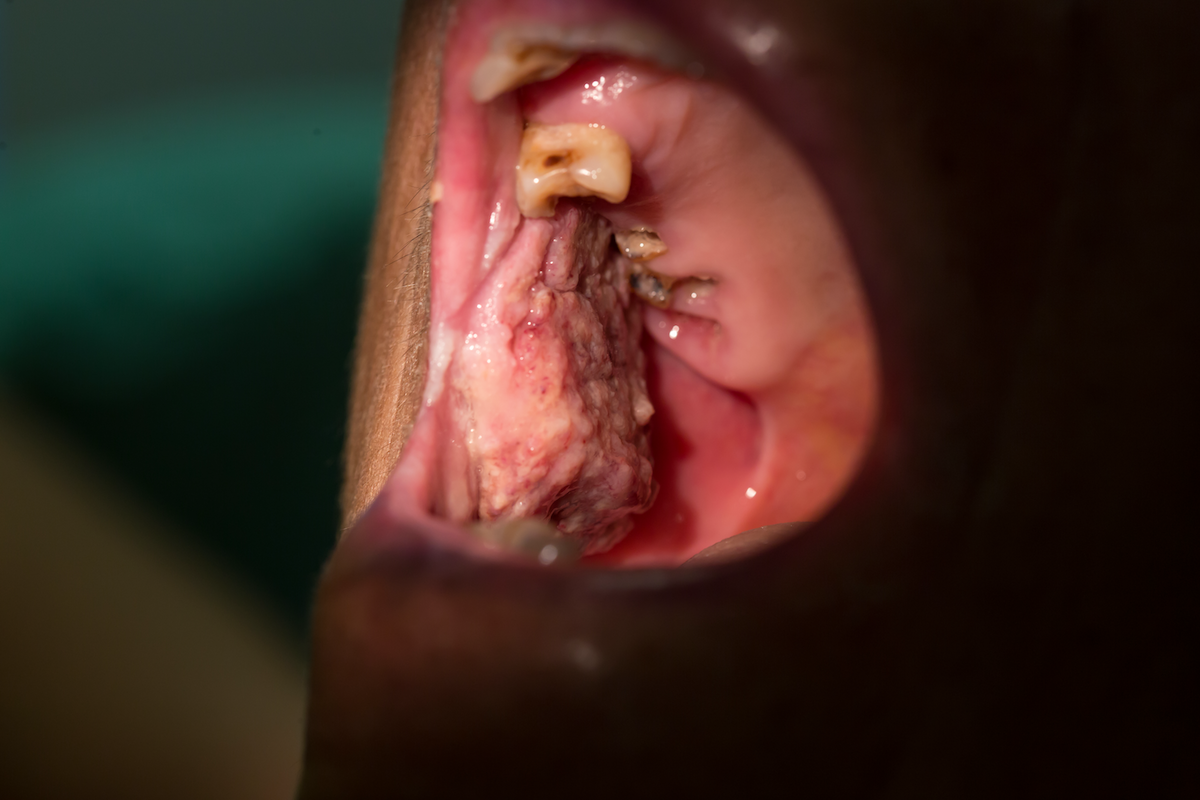Conditions: Oral tumors
While many bumps or irritated areas in the mouth may not be tumors, this page focuses on specific tumors, which are typically diagnosed by a biopsy.
Squamous cell carcinoma
Squamous cell carcinoma is the most common cancerous growth in the oral cavity. The most common cause is tobacco use, but a minority of patient with oral squamous cell carcinoma have never used tobacco, and any external cause for their cancer may remain unknown. Squamous cell carcinoma, especially when large, has a tendency to spread to nearby lymph nodes, but can occasionally spread directly along nerves or blood vessels. In the oral cavity proper, which is roughly from the back molars to the lips, the presence or absence of tumor marker p16 does not have much practical significance. This is in contrast to the oropharynx (the anatomic portion of the throat roughly from the back molars to the back of the throat, not higher than the palate, and above the “voice box”), where p16 status plays an important role in management and prognosis.
Oral tumor arising from a minor salivary gland of the palate
glandular cancers
Glandular cancers (“adenocarcinoma” of various subtypes) of the oral cavity arise from the minor salivary glands or mucus glands. There are several names within this category, but in general adenocarcinomas have the ability to grow into surrounding structures and also spread to nearby lymph nodes or elsewhere in the body, such as to the lungs. Some notable patterns of behavior are as follows: adenoid cystic carcinoma tends to travel along nerves, acinic cell carcinoma can spread to the lungs but grow so slowly there that decades may pass before any spread is evident, and carcinoma ex-pleomorphic adenoma is a cancer that arises in a benign tumor that has been present for many years.
A squamous papilloma on the tongue.
Papilloma
Papilloma is a non-cancerous growth sometimes found in the oral cavity. It is caused by the human papilloma virus (HPV). Only rarely does HPV cause cancer in the oral cavity; instead HPV more frequently causes a benign papilloma in the oral cavity. In contrast, certain strains of HPV do cause cancer in the middle part of the throat (oropharynx), but the presence of an oral papilloma does not pose an increased risk of developing throat cancer.
Leukoplakia
Leukoplakia and erythroplakia
Leukoplakia (meaning “white patch”) or erythroplakia (meaning “red patch”) are both pre-cancerous lesions, though erythroplakia is higher risk for becoming cancer. In either case, evaluation is needed to rule out cancer and discuss options.
Tori (Torus palatini and Torus mandibularis)
A common and benign condition of the upper or lower jawbones is tori. These are bony growths under a thin layer of surface lining, are rock hard and grow so slowly, many people who have them are unaware of their presence, as it simply feels like normal to them. These are typically easy for an expert (such as a dentist, oral surgeon, or head and neck surgeon) to identify and diagnose with visualization and office exam alone.
pyogenic granuloma
Other oral tumors
Several other types of oral tumors exist. Notable for the multitude of distinct tumors, the tooth forming tissues are responsible for the developement of adenomatoid odontogenic tumor, ameloblastic fibroma, ameloblastoma, ameloblastic fibrosarcoma, calcifying cystic odontogenic tumor, calcifying epithelial odontogenic tumor, cementoblastoma, cementoma, odontogenic keratocyst, odontogenic carcinoma, odontogenic myxoma, odontoma, squamous odontogenic tumor. Non-cancerous growths include fibroma, pyogenic granuloma, mucocoele (a blocked mucus gland), sialocoele (a blocked salivary gland) and ranula (a blocked duct of the sublingual salivary gland). Lymphoma, melanoma, and other types of cancers may arise in the oral cavity; definitive diagnosis is based on tissue examination under a microscope from a biopsy.
HOW TO GET THE MOST FROM YOUR APPOINTMENT
Appointment time is valuable. Below are some suggestions to make the most of your appointment. This preparation will help you and your doctor maximize efficiency and accuracy, freeing up time for questions and answers.
This page











